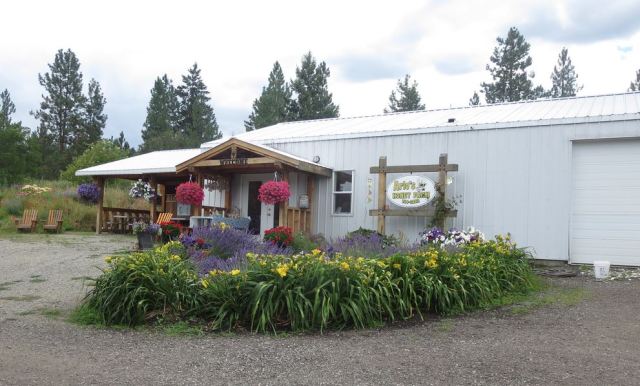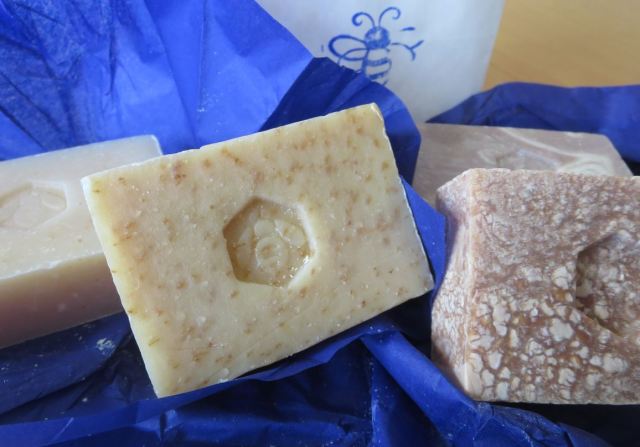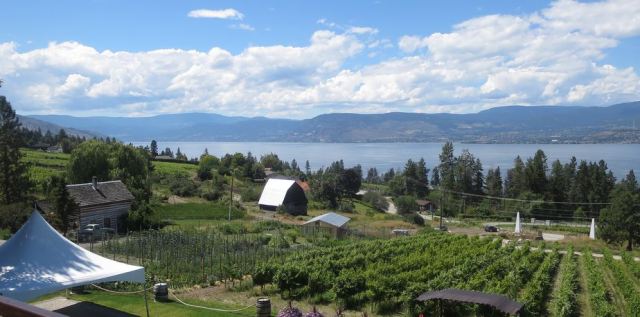My hometown – Calgary, Alberta, Canada – is having a much needed wet spell. In fact, there has been some ghastly local flooding which I’ll cover in a future blog. Lucky for me, I am a few hundred kilometres farther west, in a milder and sunnier part of Canada. I’m in the town of Kelowna, British Columbia. Kelowna is the biggest community in the Okanagan Valley, a fertile fruit and wine region with a large herd of retirees and an uncomfortable number of mansions. I can see the attraction. If I were wealthy and retired (and didn’t have kids in junior high school), I might add to the traffic snarls on a regular basis.
 I am visiting Kelowna for a number of reasons, not least of which is to learn about beekeeping near deep blue Lake Okanagan. This area is nearly a desert, but the lake’s water, used for irrigation, has turned it into an oasis of peaches, apples, and increasingly, vineyards specializing in wine grapes. There are also beekeepers who make a bit of honey and help keep the fruits pollinated.
I am visiting Kelowna for a number of reasons, not least of which is to learn about beekeeping near deep blue Lake Okanagan. This area is nearly a desert, but the lake’s water, used for irrigation, has turned it into an oasis of peaches, apples, and increasingly, vineyards specializing in wine grapes. There are also beekeepers who make a bit of honey and help keep the fruits pollinated.
After dropping into this sunshine valley (a one-hour flight from Calgary), renting a car from Enterprise, finding the rental house, and driving around in ever-widening circles atop the mountains surrounding Lake Okanagan, I set out for Arlo’s Honey Farm, perched on one of the area’s scenic hills.

I approached the honey farm from a road called Bedford and entered a lane called Bedford. The farm was unmistakable. The Arlo’s Honey Farm sign was obvious, but so were the strings of beehives stretching along the far side of the farm. The acreage was gorgeously outfitted in blossoming herbs. To my left, as I drove in, were flowers and beehives; to my right, the honey shop. I parked in front and made my way up to an outdoor sitting area. There I chatted with a family on tour from northern Alberta.

The Albertans had driven 1,000 kilometres to be here! The group had purchased some very fresh Russian garlic – stems, bulbs, sand, and all. Among the herbs and vegetables, Arlo’s sells over 50 varieties of garlic. My family grew garlic on our farm when I was a kid. I was gob-smacked to learn there are at least 50 kinds – I thought that the world has maybe 3 or 4 varieties, not 50! The folks I chatted with also showed me a jar of raw BC wildflower honey. I assured them they’d made a great choice. It was slightly darker than golden, seemed a bit cloudy with pollen and maybe even natural beeswax, but was still somewhat translucent. When I flipped their jar end-for-end, a big trapped air bubble slowly rose, telling me that this honey was seriously low-moisture. This appealed to me because I much prefer thick honey over the watery sort. I guessed that it was about 16% moisture and told the honey jar’s new owners that this sample would keep well for a long, long time. However, it looked so good that I suspect it will be gone before their car has another thousand kilometres on it.

From the picnic tables and that family of tourists, I made way behind the honey shop where another string of colonies was lined up. (They’re in the photo above.) These weren’t noticeable from the entry road, so I was surprised and delighted that I could get personal with some bees. Besides their neat and professional appearance, two things immediately caught my attention. First, the flowers (which grew right up to the hives) were buzzing with bees; and, second, the bees were curing nectar in the afternoon heat, giving off a sweet odour that told me this was a good honey day for them. I would soon learn that these flowers were no accident.
The farm was designed with bees in mind, embracing veggies and produce that flourish along with the honey bees. I was told that there are thousands of crocuses and pussy willows in March, honeyberry (haskap) in April, later, there’s crop rotation with clover, garlic (bad bugs avoid garlic and its neighbours because it’s a natural insect repellent); strawberries, raspberries, and gooseberries add to the bees’ floral treats. But at the moment, various fragrant herbs held the bees’ attention.

Arlo’s Honey Farm resident beekeeper, Helen Kennedy
Soon I was back to Arlo’s storefront, enjoying the sunshine and a pleasant chat with the beekeeper/farmer/owner. Arlo’s is named after a bear, I was told, but is run by Rick and Helen. Helen Kennedy is the beekeeper. She gave up part of her afternoon, talking bees. I wasn’t jotting down notes, but I think she told me that most of her bees were on the acreage.(*) There were somewhere about 60 colonies in the two lines that I saw. I addition to the herbs, garlic, and honey, her farm store also sells hand-made natural soap. I bought four bars – you can see them in my picture. Instead of hog’s lard and willow ashes, Helen uses her honey, plus the oils of almond, palm, sunflowers, and tea tree, along with grains and the like to make her various soap varieties. (The soaps smell delicious – it’s hard to remember not to eat them.)

Helen told me that (just like everywhere) they have good years and bad years, mostly dependent on rainfall and seasonal weather. One key to her success is the idea that “healthy bees are happy bees” – by maintaining a clean, low-stress environment, her bees live a healthy and happy life. From the spring crocus bloom through to the autumn asters, the bees usually have something to feast upon every day. While I was visiting, I saw bees on sedum, cleome, calendula, and lavender.
In this hot dry valley, thick, low-moisture honey is pretty much guaranteed. I told her that I’d guessed that the jar she’d sold a bit earlier was 16% moisture. “Our honey usually runs 15%,” Helen told me. I couldn’t resist, so I asked her to sell something unusual to me. She brought me a jar of elderberry honey. This is a variety of honey which I’d never had before. In tomorrow’s blog, I’ll show you elderberry honey and tell you what it was like.

(*) correction: In the original post, I said that Arlo’s keeps most of their hives on their farm. Since then, Helen Kennedy told me that they operate a few hundred hives and keep eight outyards.

Fascinating. I’m intrigued at how you could guess the moisture content from the movement of the air bubble. Could you explain a bit more about the science behind that?
LikeLike
Hi Emily,

There’s neither black arts nor sorcery involved! I think anyone could learn this – it just takes time and practice. I was taught the bubble trick by a Canadian federal honey inspector who worked for the Canadian Food Inspection Agency. He drove out to my farm with all the proper equipment (Pfund grader, refractometer, sample spoon (with a half-metre-long handle to scoop down deep into the barrels), sample jars). Before putting a dab of honey into the refractometer, he flipped the liquid honey’s sample jar and watched the bubble rise. “About 15-and-a-half,” he said. It was 15.4% moisture. He said you don’t actually time the bubble’s movement, you just watch it and its shape. That was over 30 years ago. Since then I’ve had the chance to do this test hundreds of times. (Until last year, I spent a few seasons as chief judge of our local honey shows. After grading is all done, I still would sometimes roll a sample or two to keep the skill up.) By the way, if you use an 18% jar and a 16% jar to practice, you will immediately see a big difference in the way that the air bubble rises!
Ron
LikeLiked by 1 person
Fascinating, thank you. Not a skill I’ve heard anyone mention before. Useful if you don’t have a refractometer on you.
LikeLiked by 1 person
Wouldn’t work here in England as my main crop is oil seed rape and that sets like concrete. It’s been known to bend many a spoon! I’m going to try it on the fresh stuff next time though.
LikeLike
We produce canola, too. Tough stuff, isn’t it? You have to heat and liquefy the honey first if you want to try this. (You have to melt granulated honey to use a refractometer, too.)
LikeLiked by 1 person